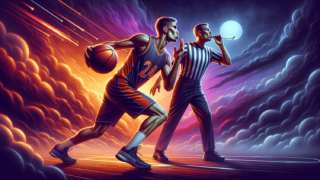
Understanding the Flopping Violation in Basketball
Written by: Basketball Universe
Last updated:

Welcome to the fascinating world of basketball, where athletic prowess meets tactical brilliance! Today, we’re diving headfirst into one of the sport’s most controversial plays – the notorious flopping violation. If you’re aiming to become a true basketball guru, understanding this tactic is simply non-negotiable. So, sit back and join us as we demystify the intricate act of flopping, unravel its complex web of rules and penalties, and examine how it’s evolved over the years. Get ready for the perfect blend of excitement and knowledge that will quench your thirst for hoops mastery!
Understanding the Flopping Violation in Basketball
Flopping is a deceptive tactic in basketball where a player exaggerates contact or fakes a foul in an attempt to trick referees into calling a foul on their opponent. The NBA regards such actions as unsportsmanlike and has imposed rules to penalize players who blatantly flop. Violations can result in warnings, fines, or even suspensions, depending on the severity and frequency of the flop. Because it undermines fair play and sportsmanship, understanding and identifying flopping is crucial for players, coaches, and referees alike.
Unveiling the Art of Flopping
Though frowned upon in the basketball world, flopping is an art that requires acting skills and a perfect sense of timing. Players study their opponents and exploit situations to their advantage, often in high-pressure moments. Popular flopping techniques include locking arms with opponents, taking a charge, or exaggerating contact after a shot. To fully grasp the intricacies of flopping, let’s break down some of its most common forms.
The Classic Charge Flop
A tried-and-true technique, the charge flop happens when a defender falls to the ground, exaggerating contact with the offensive player. The goal is to draw an offensive foul on the opponent, often claiming they initiated the contact. To identify and appreciate the skill behind a charge flop, watch for a defender who dramatically leans in and falls backward after encountering an offensive player.
The Flail Flop
Here’s where the real drama comes in. When an offensive player flails their arms or head, imitating the impact of illegal contact with a defender, we call it a flail flop. Top actors in the sport can create a foul out of thin air, even when no contact has occurred. To spot this clever maneuver on the court, keep an eye out for an offensive player who looks like they’ve been struck by the world’s strongest invisible force.
The Post-Up Flop
A slight alteration of the classic charge flop, the post-up flop is aimed at drawing a foul on a player posting up (an offensive player using their back to shield the defender). In this case, the defender feels the force from the offensive player, then slumps or falls to the floor, heightening the physicality of the situation. This can be a sneaky yet effective way for a defender to turn the tables and put their team back in control. Look for a defender who suddenly collapses during a post-up, making it appear as though they’ve received unwarranted aggression from the offensive player.
A Deep Dive into the History of Flopping
Flopping has been part of the game for decades, with its origins dating back to the early days of professional basketball. To gain an understanding of how flopping has evolved over time, let’s take a trip down memory lane and explore its history in the NBA.
The Emergence of Flopping in Pro Basketball
In the early years of pro basketball, flopping wasn’t seen as a major issue. It was a tactical ploy used by players who took advantage of loose officiating and refs who couldn’t rely on instant video replays. As the game progressed and players’ acting skills improved, so did the frequency and sophistication of flops.
The Flop’s Heyday and the Rise of the “Finesse” Player
From the 1970s through the 1990s, the NBA witnessed the rise of the “finesse” player – skilled athletes who didn’t rely solely on physicality to outsmart their opponents. Crafty and intelligent, these players were masters at exploiting the rules to gain an edge. Flopping became increasingly prevalent as more players saw it as a necessary tactic for success. Some of the game’s most celebrated athletes have been known to add a little theatrics to their performance, all in the name of winning.
Flopping and the NBA Rulebook
As flopping continued to escalate, the NBA took notice and sought measures to address this unsportsmanlike behavior. Understanding how basketball rules have adapted to prevent and punish flopping will give you insider knowledge of the game.
The Introduction of the Flopping Rule
In 2012, the NBA introduced a rule specifically targeting flopping, intended to penalize players caught exaggerating contact. With video replays and reviews becoming an essential aspect of officiating, referees now had a powerful tool for identifying and judging flops. This new rule aimed to counteract the deceitful behavior and create a level playing field.
The Punishments: Warnings, Fines, and Suspensions
Once the NBA identified a flopping issue, it established a system of penalties to deter players from continuing the misconduct. For a first offense, the player receives a warning. Repeat offenders face escalating fines that increase with each additional offense. The fines are as follows:
- 2nd offense: $5,000
- 3rd offense: $10,000
- 4th offense: $15,000
- 5th offense: $30,000
Should a player continue to flop beyond their fifth offense, the NBA may impose harsher penalties, including suspensions or increased fines.
Impact of the Flopping Rule on the Game
By implementing regulations to counteract flopping, the NBA has changed the dynamics of the game. And while the rules have shifted the way some plays are executed, flopping has not been entirely eradicated.
Has Flopping Decreased?
While it’s challenging to quantify how the new regulations have affected the prevalence of flopping, they have undoubtedly discouraged the practice to some extent. Players and coaches now think twice before attempting to blatantly deceive referees, lest they face penalties that could hurt their teams’ performance and their bank accounts.
Tactics for Avoiding Flop Violations
With increased scrutiny, savvy players have developed strategies to navigate the anti-flopping rules. Some may choose only to flop when they believe it is a surefire way of drawing a foul, while others have honed their techniques to make their flopping more believable and harder to detect by referees.
Flopping in Basketball: A Love-Hate Relationship?
From fans to players, coaches, and referees, opinions on flopping differ widely. Some view it as an unnecessary blight on the game, while others consider it a legitimate skill or clever tactical play. To truly appreciate the role of flopping in basketball, it’s important to understand where these different perspectives stem from.
The Purist’s View
Basketball purists take a strong stance against flopping, viewing it as deceptive and unsportsmanlike. They maintain that the game should uphold fair play and values such as integrity and honor. In the eyes of the purist, flopping taints the spirit of the sport and should not be tolerated.
The Realist’s View
Realists, on the other hand, accept flopping as a part of the game. They believe that players should use every tool at their disposal to gain an advantage, within the confines of the rules. In their eyes, if a player can draw a foul with a well-executed flop, it’s simply another aspect of their skill set. While realists may not particularly like flopping, they acknowledge its role in the sport.
The Referee’s Perspective
Referees must walk a fine line between maintaining fair play and allowing the game to flow. Their job entails detecting and punishing flops, and they rely on their training and instincts to make tough judgment calls. With instant replay technology now widely available, referees must balance the need for accuracy with the importance of play continuity. They’re continually adapting as players perform new and more convincing versions of the flop.
Mastering the Flop for Recreational Basketball Players
While this article focuses on the NBA and its relationship with flopping, recreational players can also learn a thing or two about how to use or defend against flopping in a friendly game.
When to Flop (and When Not to)
If you decide to employ flopping in your arsenal of basketball tricks, it’s essential to choose your moments wisely. While a well-timed flop could win you a critical foul, an obvious or untimely flop might earn you the ire of your fellow players, especially if you’re playing a casual pick-up game. Remember to consider the sportsmanship aspect and the spirit of fair play before planning your next great performance.
How to Defend Against a Flopper
Just as understanding the art of the flop can be useful, knowing how to defend yourself against a flop artist is equally important. Be aware of the defensive tactics that may come into play, such as a player suddenly collapsing during a post-up or exaggerating contact with you. Alert teammates and referees to your suspicions, and avoid engaging in overly physical play with a known flopper – this will only provide them with more opportunities to embellish contact.
A Deeper Understanding of the Flopping Violation in Basketball
By delving into the world of flopping in basketball, we’ve gained a more comprehensive understanding of this widely debated tactic, its forms, history, and the rules and enforcement surrounding it. With this newfound knowledge, you’re now better prepared to navigate the thrilling and complex landscape of basketball, whether you’re hitting the court or shouting from the sidelines.
Notable Moments of Flopping in the NBA
Now that we’ve examined the ins and outs of the flopping violation, it’s essential to take a look at some memorable flopping moments in NBA history. These examples will provide further context and showcase the evolution of flopping tactics.
Vlade Divac and the Art of the Flop
Vlade Divac, a Serbian-born center, was known for his outstanding skills on the court as well as his ability to draw fouls using flop techniques. Divac frequently used the charge flop and had a knack for drawing opponent fouls by exaggerating contact. While flopping had already existed before his time, Divac popularized the art, and his name became synonymous with NBA flopping.
Manu Ginóbili and the Splendid Dive
As an Argentine-Italian shooting guard, Manu Ginóbili was considered one of the NBA’s most captivating players. Beloved for his incredible athleticism and strategic moves, Ginóbili was also known for his creative flopping techniques. He often collapsed to the ground to imitate an opponent’s rough contact, corroborating the phrase “flop or die” and demonstrating how sometimes a well-executed flop could change the game’s outcome.
LeBron James and the Flail Flop
While LeBron James is undoubtedly one of the NBA’s all-time greats, he’s also become known for his occasional and exceptional flop performances. James has mastered the art of the flail flop when it is least expected, drawing fouls from disbelieving players and leaving the audience awestruck. LeBron’s flopping incidents have sparked some serious discussion and debate about how even accomplished players engage in these deceptive tactics to gain a competitive edge.
Addressing the Flopping Controversy in Basketball
The ongoing controversy surrounding flopping in basketball raises many questions around the very nature of the game, what it stands for, and the balance between fair play and competitiveness.
Flopping: Strategy or Cheating?
Some may argue that flopping is ultimately a strategic play, one that rewards players who can manipulate the game to their advantage. Critics, however, classify flops as cheating, a practice that undermines the spirit of sportsmanship and fairness for which basketball is renowned. As the debate continues, it’s crucial to balance these different perspectives when assessing the prevalence and impact of flopping in basketball.
The Future of Flopping and Rule Enforcement
With basketball continuing to evolve at an astonishing pace, the NBA and other basketball associations worldwide will need to adapt their rules and regulations accordingly. As players devise new and more advanced flopping tactics, innovative approaches must be employed by governing bodies to ensure a fair and level playing field. In the future, we might see stricter penalties or technological advancements applied to maintain the spirit of the game and keep the focus on sportsmanship rather than deceit.
Frequently Asked Questions about Flopping in Basketball
As a basketball enthusiast, you may have some questions about the flopping violation, its history, and how it impacts the game. Here are the answers to ten frequently asked questions related to flopping in basketball.
1. What is flopping in basketball?
Flopping is a deceptive tactic used by a player who exaggerates contact or fakes a foul to fool referees into calling a foul on their opponent. Players who successfully perform this act often gain an advantage, such as free throws or possession of the ball.
2. When did flopping become an official violation in the NBA?
Flopping became an official violation in the NBA with the introduction of a specific anti-flopping rule in 2012. This rule was implemented to discourage players from using this tactic and maintain the game’s integrity and fairness.
3. How is a flopping violation detected and penalized?
A flopping violation is detected by referees observing the game in real-time and through the use of instant replay technology. The NBA has established a system of penalties for flopping violations, including warnings, fines, and possible suspensions for repeated offenses.
4. How has the introduction of the flopping rule impacted the game?
Since the introduction of the anti-flopping rule, the prevalence of flopping has somewhat decreased. Players are more cautious about attempting to deceive referees, and the rule’s enforcement aims to uphold fair play and sportsmanship in basketball.
5. Who are some famous NBA players known for flopping?
Some notable NBA players known for flopping include Vlade Divac, Manu Ginóbili, and LeBron James. These players have made headlines for their on-court acting skills and ability to draw fouls using flop techniques.
6. What are some common flopping techniques?
Common flopping techniques include the classic charge flop, the flail flop, and the post-up flop. Players use these techniques to imitate contact, exaggerate the force of a collision, or draw attention to an opponent’s perceived foul.
7. Is flopping only an issue in the NBA?
No, flopping is not exclusive to the NBA. It’s also prevalent in other leagues and in international basketball tournaments. However, the NBA has taken proactive steps to address and penalize flopping to deter players from engaging in the tactic.
8. Is flopping considered a skill or cheating?
The perception of flopping as a skill or cheating varies from person to person. While some consider it a strategic move, others regard it as unsportsmanlike behavior that undermines the spirit of fair play in basketball.
9. What are the penalties for a flopping violation in the NBA?
Penalties for flopping violations in the NBA include a warning for a first-time offense, followed by fines ranging from $5,000 to $30,000 for subsequent offenses, and possible suspensions or increased fines upon exceeding five offenses.
10. Can recreational basketball players use flopping techniques?
Recreational basketball players can use flopping techniques, but it’s essential to consider the atmosphere of the game and the sportsmanship aspect. In casual pick-up games or friendly competitions, deploying such tactics might be frowned upon by fellow players who prioritize the spirit of fair play.
Featured Posts
- No pillar pages found.





